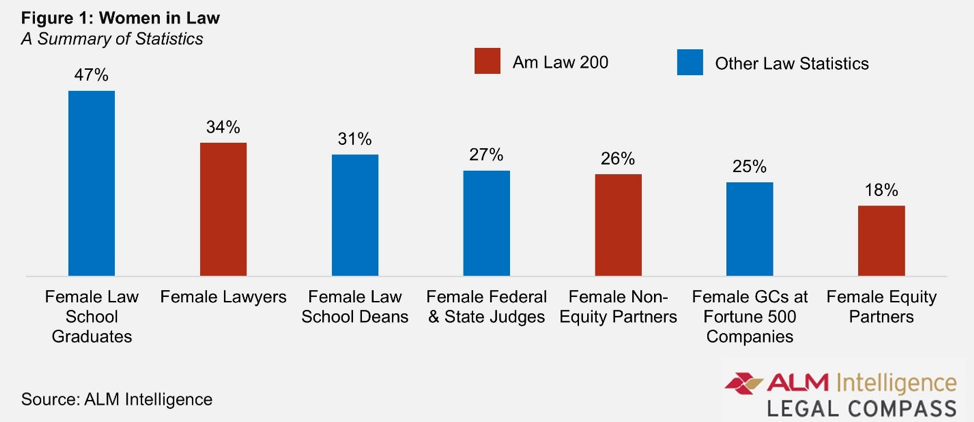Blog
Understanding the Gender Wage Gap in the Legal Profession
6/20/2018 8:00:00 AM

While in some industries, the old boy networks are slowly dying out, in others, they are still alive and well. Though lawyers attempt to bring about equality through their service to clients, the industry as a whole is still male-dominated and governed.
Before the dilemma can be remedied, legal professionals and others in the community must understand the gender wage gap and its prevalence in the legal industry.
What Is the Gender Wage Gap?
The gender wage gap refers to the earnings that a woman makes in comparison to what a man makes who has the same position. The average gap in the United States is 78 percent, meaning that the average woman earns 78 cents for every dollar that a man earns in the equivalent position.
The first highly publicized recognition of this issue arose when President Kennedy passed the Equal Pay Act in 1963, which helped to increase women’s pay to match the earnings of men’s pay.
However, many industries continue to subsequently give men a greater amount of compensation for male-dominated positions. The legal industry has invariably been exposed to this problem and the general sentiment holds true today.
How Is the Legal Industry Affected by the Gender Wage Gap?
The gender wage gap is seen in multiple aspects of the legal industry. Although more than half of new law school students are female, there is still disparity in the pay women receive in the profession.
Legal occupations have some of the greatest disparity in wages between male and female employees that are not due to their level of education or years of experience -- with several positions having as much as 38.6 percent disparity levels.
Some ways that the gender gap is present in the legal workplace include:
Men Have More Prominent Legal Jobs
On average, female lawyers have lower salaries than men regardless of how long or how much effort exerted in their profession. According to the U.S. Census Bureau, full-time female lawyers earn only 77 percent of what males in the same positions earn.

Pay disparity continues even though women tend to bill more accounts than men. Oftentimes, women lawyers are billed at lower rates than men. Although women make up about one quarter of the general counsel positions at Fortune 500 companies, they are paid less than men. Of these positions, men earned 17.5 percent more than their women counterparts with men having an average salary that was 6.3 percent higher and bonuses 31% higher than women.
Among the AmLaw 200, women make up only 4 percent of executive management overall and 19 percent of all equity partners. Further data demonstrates that the higher the compensation level, the greater the pay increase is favored toward men.
The Wage Gap Among Equity Partners Has Increased
The gender wage gap of equity partners has increased. Even if women make it to this top post, they still make less money than male equity partners.
Practice Area Disparity Impacts Pay
Part of the disparity may be attributed to the fact that men and women may work in different legal practice areas that are associated with different rates of pay.
For example, more women gravitate toward employment law, property law and family law. Men are more often gravitated toward banking and finance, mergers and acquisitions and commercial litigation, which tend to provide greater compensation.
What May Change the Gender Wage Gap in the Legal Industry?
This gap is a pervasive problem in the legal industry, so any significant change will have to come from a multi-faceted approach, beginning with hiring decisions and continuing through each stage of the workplace culture. Investors and others are increasingly looking to new technology to address their legal needs, so the use of new delivery models and a replacement of the old model may help spur this change.
Additionally, larger legal corporations may insist upon diversity to help address this problem. Legal organizations that have at its core the value of equality among genders can help influence this change.
Where to Start
Legal organizations can galvanize change by providing greater opportunity for advancement and initiatives for mentoring. Additionally, there is an imminent need to provide greater work-life balance in allowing women with children to make parenting a priority in their lives, without the commonly associated stigma of incompetence.
Providing flexible work conditions can boost productivity by permitting legal professionals to complete projects outside of regular working hours. Adapting a zero-tolerance policy regarding discrimination can also assist legal organizations seeking to combat this continuing epidemic.
Request a Proposal
If you are interested in any of our services, you can request a proposal by filling out the fields in this section.
CONTACT US
- Case Inquiry
- 1-800-207-7160
- info@JNDLA.com
- www.JNDLA.com
- Jen@JNDLA.com
- Neil@JNDLA.com
- David@JNDLA.com
- Careers@JNDLA.com
FOUNDING PARTNERS
JOIN US